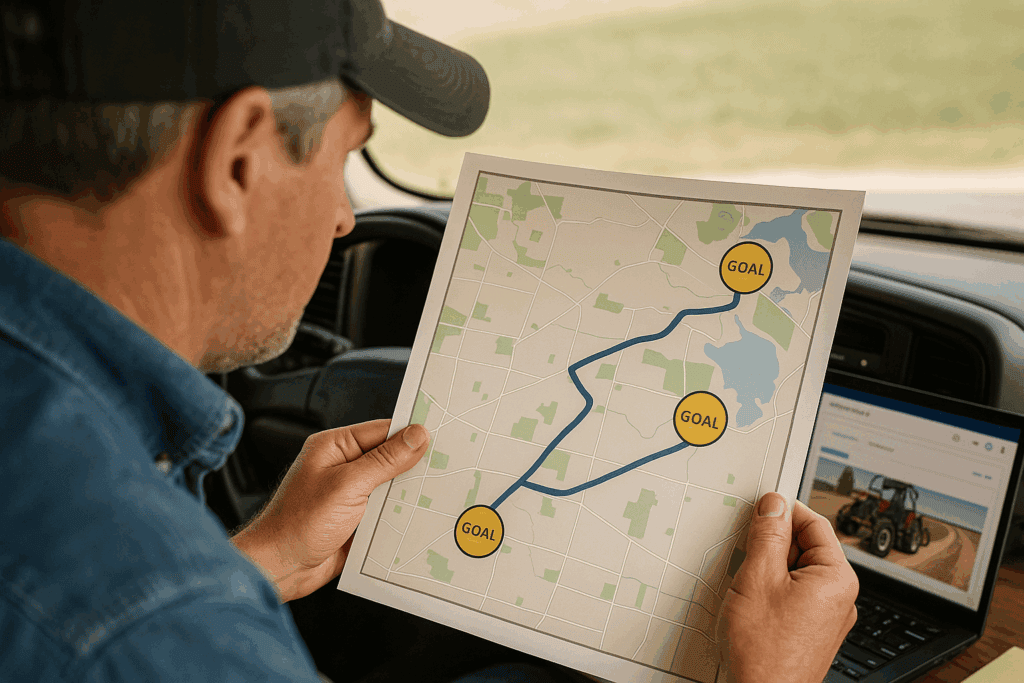You wouldn’t plant without a plan—so why advertise without one?
Imagine hopping in your truck with no idea where you’re going. No map, no GPS, no destination—just burning fuel and hoping you end up somewhere useful.
That’s what it’s like when businesses run internet ads without a solid marketing plan. You’re spending money, putting out content, maybe getting a few clicks… but where is it taking you?
A marketing plan gives your internet advertising a direction. It’s the GPS for your goals, your customers, and your budget.

Your Marketing Plan Is the Road Map
Just like farming, success in advertising comes down to planning. You prep the soil before planting. You schedule your spray. You don’t just wing it and hope for the best.
Marketing is the same.
A clear plan helps you:
- Stay on track
- Spend your budget wisely
- Reach the right people
- Know what to do next
Let’s break it down.
1. Set Your Destination: What Are You Trying to Achieve?
You don’t leave the farm without knowing where you’re headed. Same with advertising.
Start with your goals:
- More traffic to your website?
- More calls or contact form fills?
- Selling specific products or clearing old inventory?
- Growing awareness of your dealership or service?
Once you know where you’re going, you can plan the best route.
Pro Tip: Write your top 1–2 goals down. Make sure every internet ad you run supports one of those goals.

2. Know Who You’re Trying to Reach
You don’t sell the same thing to everyone. Your internet advertising should target the people most likely to buy.
Ask:
- What do they care about?
- What problems are they trying to solve?
- What words do they search online? (“combine for sale near me” or “best grain cart for small farm”)
The better you understand your customer, the better your ads will perform.

3. Don’t Just Drive—Plan the Route
Random ads at random times won’t get you far. Plan out your year based on your sales cycle.
Think like this:
- Spring: Focus on planters, tillage, sprayers
- Summer: Push trade-ins, used equipment, and services
- Fall: Harvest equipment, storage, and prep for winter
- Winter: Build awareness, offer financing, promote maintenance
This keeps your internet advertising steady and connected—not just “one and done” ads.
4. Pick the Right Roads: Where Will You Advertise?
There’s more than one route to reach your audience. Choose platforms that match your customer’s habits.
- Google Ads: Great for buyers who are actively searching
- Facebook & Instagram: Good for brand awareness, product highlights, and retargeting
- Email: Best for staying in touch with leads and past buyers
- YouTube or video content: Useful for showing equipment in action
You don’t need to be everywhere—just where it matters.
5. Use the Signs Along the Way: Measure What’s Working
Would you keep driving if all your signs were pointing the wrong direction?
Same thing with your marketing. If your internet advertising isn’t getting clicks, calls, or sales, it’s time to adjust.
Track things like:
- Click-through rate (CTR)
- Cost per lead
- Keyword performance
- Traffic sources
- Conversions (calls, forms, purchases)
When you see what’s working, do more of it. When it’s not—take a new route.

A Map Makes the Difference
You wouldn’t spray without knowing the field boundaries. You wouldn’t haul a load without knowing the destination. And you shouldn’t advertise without a plan.
A marketing plan makes internet advertising more effective, more consistent, and more profitable.
It helps you go from “We need more business” to “Here’s how we’ll get it.”
Tired of going from one campaign to the next?
Let Fastline Marketing Group build your road map to successful marketing
Contact us today to get started!


